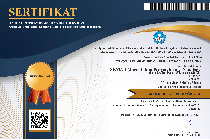APLIKASI TEPUNG LIMBAH PENETASAN DALAM RANSUM UNTUK MENINGKATKAN PRODUKTIVITAS ITIK LOKAL DI KELOMPOK TERNAK DESA GAUM, KECAMATAN TASIKMADU, KABUPATEN KARANGANYAR
Abstract
The ducks hatchery produces a number of waste comprises empty shells from hatched eggs, infertile eggs, dead embryos, and unhatched eggs. The presence of the waste in large amount can cause an environmental pollution. Furthermore, it has a potential but has not received enough attention in terms of utilization as feed ingredient in poultry ration. It contains a substantial amount of nutrients such as protein and calcium, and can be processed into hatchery waste meal that can be applied as an inconventional feed ingredient in ducks ration. The purpose of this activity was to process the ducks hatchery waste into hatchery waste meal to be applied in the ration of local ducks. We colaborated with the Farmers Group of Sabar Sabar 1 and Subur Subur 2 in the Village Gaum, Tasikmadu, Karanganyar. This activity comprises of two stages. The first stage was instructional methods and dialogue through socialization, whereas the second stage was the practical of the hatchery waste meal production and its application in ration. The benefits of this activity is the application of hatchery waste meal can increase ducks productivity, minimize the costs of ration and can reduce the impact of hatchery waste on environmental pollution.
Full Text:
PDFReferences
Indreswari, R. dan A. Ratriyanto. 2015. Pemanfaatan Limbah Penetasan Sebagai Bahan Pakan Alternatif Itik Lokal Jantan Guna Mendukung Usaha Peternakan Ramah Lingkungan (Lanjutan). Laporan Penelitian. Fakultas Pertanian, Universitas Sebelas Maret. Surakarta.
Iyayi, E.A. 2008. Prospects and challenges of unconventional poultry feedstuffs. Nigerian Poultry Science Journal. 5: 186194.
Khan, S.H. and B.M. Bhatti. 2001. Effect of autoclaving, toasting and cooking on chemical composition of hatchery waste meal. Pakistan Veterinary Journal. 21 : 22-26.
Lilburn, M.S., G.W. Barbour, R. Nemasetoni, C. Coy, M. Werling and A.G. Yersin. 1997. Protein quality and calcium availability from extruded and autoclaved turkey hatchery residue. Poultry Science. 76 : 841-848.
Mehdipour, M., M. S. Shargh, B. Dastar and S. Hassani. 2009. Effect of different level of hatchery waste on the performance, carcass and tibia ash and some blood parameters in broiler chicks. Pakistan Journal of Biological Sciences 12: 1272-1276.
Miller, B. F. 1984. Extruding hatchery waste. Poultry Science. 3:1284–1286.
Riady, M. 2006. Pengembangan teknologi inovatif bidang peternakan untuk mendukung ketahanan pangan nasional. Dalam: Prosiding Seminar Nasional Pengembangan Teknologi Inovatif untuk Mendukung Pembangunan Peternakan Berkelanjutan. Fakultas Peternakan Universitas Jenderal Sudirman. Hal 1:12.
Shatishkumar, A. and R. Prabakaran. 2008. Recycling of Japanese quail hatchery waste on egg production performance of quail breeders. Journal Veterinary and Animal Sciences 4: 123-128.
Standar Nasional Indonesia. 2006. SNI 01-3908-2006 Ransum Meri (Duck Starter). Badan Standardisasi Nasional, Jakarta.
Tymczyna, L., A. ChmielowiecKorzeniowska and L. Saba. 2000. Effect of a pig farm on the physical and chemical properties of a river and ground water. Polish Journal of Environmental Studi. 9:97-102.
Refbacks
- There are currently no refbacks.























